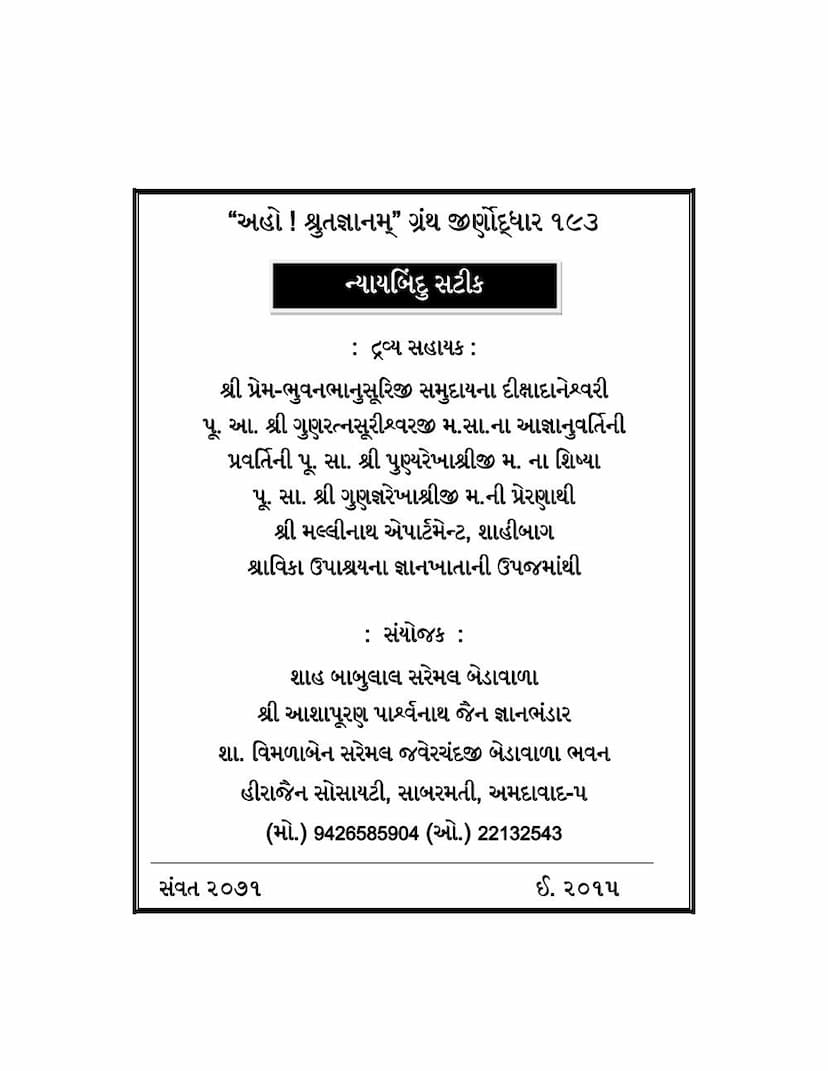Nyayabindu
Added to library: September 2, 2025

Summary
This document describes the book "Nyayabindu" by Dharmottaracharya, published by Chaukhambha Sanskrit Granthmala. The text itself is a detailed list of books digitized and archived by the Shri Ashapooran Parshwanath Jain Gyanbhandar as part of the "Aho Shrutgyanam Granth Jino-uddhar" project.
Here's a breakdown of the key information:
Book: Nyayabindu Author: Dharmottaracharya Publisher: Chaukhambha Sanskrit Granthmala Catalog Link: https://jainqq.org/explore/034224/1
Project Context: The bulk of the provided text is a catalog of books digitized into DVDs by the Shri Ashapooran Parshwanath Jain Gyanbhandar. This project, "Aho Shrutgyanam Granth Jino-uddhar," aims to preserve and make accessible rare and ancient Jain texts. These digitized books are also available for download from the website www.ahoshrut.org.
Content of the Catalog: The catalog lists hundreds of Jain and Sanskrit texts, including:
- Jain Agamas and Commentaries: Works like Nandi Sutra Avchuri, Uttaraadhyayan Sutra Churni, Arhadvita-Bhagavadgita, Arhatchudamani, Nyayapraveshah, Nyayavtar, Syadvad Ratnakar, Sanmati Tark Prakaran, and various commentaries on these texts.
- Works on Jain Philosophy and Logic (Nyaya): Several titles directly related to logic and epistemology are listed, such as Nyayapraveshah, Nyayavtar, Syadvada Ratnakar, and the focus text, Nyayabindu. The presence of these indicates a strong emphasis on logical and philosophical studies within the Jain tradition.
- Works on Jain History, Culture, and Practices: Books on Jain culture, history, music, temple architecture, inscriptions, and biographies are included.
- Sanskrit Literature and Shastra: A significant portion of the catalog comprises classical Sanskrit works on various subjects, including philosophy, poetry, grammar, astronomy, medicine, and architecture. This highlights the broad scope of knowledge preserved and promoted by the institution.
- Manuscript Catalogs: Some entries are lists of manuscripts from various Jain Bhandars, indicating a systematic effort to document and catalog available resources.
Key Figures Involved:
- Dharmottaracharya: The author of Nyayabindu, a significant work on Jain philosophy and logic.
- Chandrashekhar Shastri: The Hindi translator and editor of the Nyayabindu. His preface and historical notes provide valuable context for the book and the history of Buddhist logic.
- Dharmakirti: The original author of the Nyayabindu, a prominent Buddhist philosopher.
- Shah Babulal Sanermal: The coordinator of the Shri Ashapooran Parshwanath Jain Gyanbhandar and the project.
- Various Acharyas and Scholars: The catalog lists numerous scholars and Acharyas associated with the editing and publication of these texts, showcasing a rich intellectual lineage.
Historical and Philosophical Context (from the Hindi introduction):
The introduction, written by Chandrashekhar Shastri, provides a detailed historical overview of Buddhist logic and its development. It discusses:
- Early Buddhist thought: The initial stages of philosophical inquiry in Buddhism.
- The influence of Sanskrit: How Sanskrit became the dominant language for Buddhist philosophical literature.
- Key Buddhist philosophical schools: Vaibhashika, Sautrantika, Madhyamika, and Yogachara, and their respective tenets.
- The development of Buddhist logic: The contributions of figures like Dignaga and Dharmakirti in systematizing Buddhist epistemology and logic. Shastri highlights Dignaga as the father of modern Buddhist logic and Dharmakirti as its reviver.
- Dharmakirti's life and works: His philosophical journey, his debates with other scholars, and his major works, including Nyayabindu.
- Dharmakirti's place in Buddhist philosophy: Shastri analyzes Dharmakirti's position within the Buddhist schools, leaning towards the conclusion that he was a follower of the Bahyarthastitivada (realist) school.
- Dharmakirti's critique of Dignaga: The introduction details specific logical points where Dharmakirti differed from Dignaga's views.
Summary of "Nyayabindu":
While the provided text primarily focuses on the catalog and the historical introduction to the broader project, it also includes parts of the Nyayabindu itself and its commentary. The Nyayabindu, authored by Dharmakirti and commented upon by Dharmottaracharya, is a foundational text in Buddhist logic.
Based on the table of contents and the translated sections:
- Structure: The Nyayabindu is divided into three chapters (Parichchhedas):
- Pratham Parichchhed (First Chapter): Deals with Pramana (means of knowledge) in general, its definition, and the nature of Pratksha (perception). It also categorizes Pratksha into four types: Indriyajnyanam (sensory perception), Manovijnyanam (mental perception), Atmasamvedanam (self-awareness), and Yogipratyksham (yogic perception). It also defines Swalakshana (individual characteristics) as the object of perception.
- Dwitiya Parichchhed (Second Chapter): Focuses on Anumana (inference). It divides Anumana into Swartha (inference for oneself) and Parartha (inference for others). Swartha Anumana is described as knowledge derived from a valid 'Trirupa' (three-marked) sign or 'Ling' (reason). It elaborates on the three characteristics of a valid reason (Ling): presence in the subject, presence in the similar, and absence in the dissimilar. It also discusses various types of 'Anupalabdhi' (non-apprehension) as a valid means of knowledge, particularly for negations.
- Tritiya Parichchhed (Third Chapter): Continues the discussion on Parartha Anumana (inference for others), explaining it as the exposition of the Trirupa Ling. It outlines two forms of Parartha Anumana: Sadharmyavat (similarity) and Vaidharmyavat (dissimilarity). It also details various 'Hetvabhasas' (fallacies of inference) and 'Drishtantabhasas' (fallacies of example), categorizing them based on how they violate the valid characteristics of a reason or example.
In essence, the provided text is a comprehensive record of a project to preserve and digitize valuable Jain and Sanskrit literature, with a particular focus on the foundational text of Buddhist logic, Nyayabindu, and its commentary. The introductory material offers significant historical and philosophical context for the study of Buddhist logic.